Matthias Reissner’s German Brown Bread recipe led us to Homemade Diastatic Malt Powder!
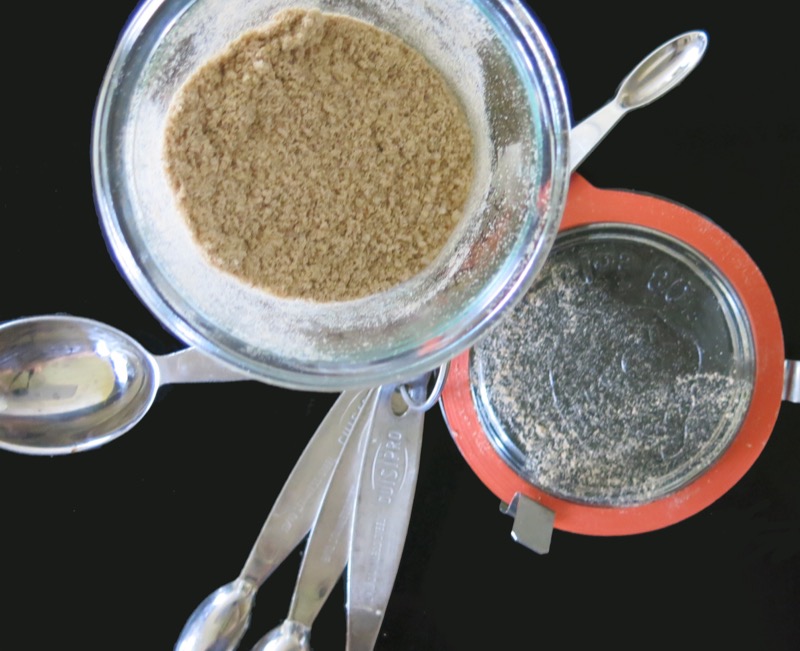
It is such a beautiful thing. Really easy to make and a profound addition to any homemade bread dough flavour, texture and crunchy crust. Who knew baking could lead one down such heady paths?

The remainder of my batch is relatively small, as I shared with all of my Thermomix Consultants. That was part of my Christmas gift to each of them. Matthias created this phenomenal recipe for German Brown Bread which requires a Rye Sourdough Starter and Diastatic Malt Powder. He demonstrated the bread making at our Christmas Meeting and I gifted each with a batch of Homemade Rye Sourdough Starter and this amount of Diastatic Malt Powder that he taught me to make. Thus, all were set to go straight home and make his recipe! (Don’t think anyone has yet, but me? Hopefully, we will hear from each, soon…. one by one…. that these little helper-gifts aided their German Brown Bread making experience!)
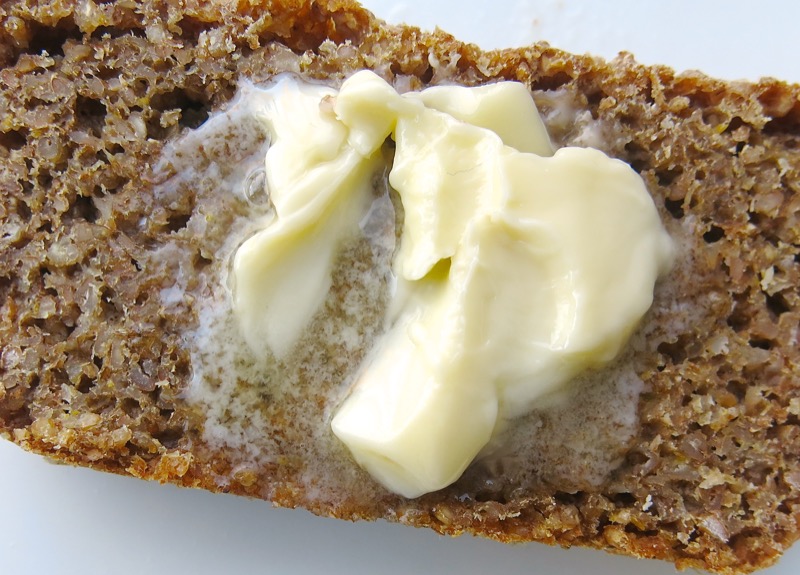
Meanwhile, I have made it several times since. I am practically addicted to the taste, texture, crunch and wholesomeness of this loaf! It tastes like the breath of life itself!

So, what is Diastatic Malt Powder, you may ask? I certainly did! Never heard of it before. I was hoping it was the same key ingredient for Malted Milk Shakes and Malted Chocolate Balls. Nope. That is another kind of Malt Powder. Not so vastly different than this one. But, different enough as it is non-diastatic malt powder and added to ingredients as a sweetener and flavour enhancer. It does not possess the magical power of Diastatic Malt Powder which ultimately enable a “super-feed” for yeast in dough.
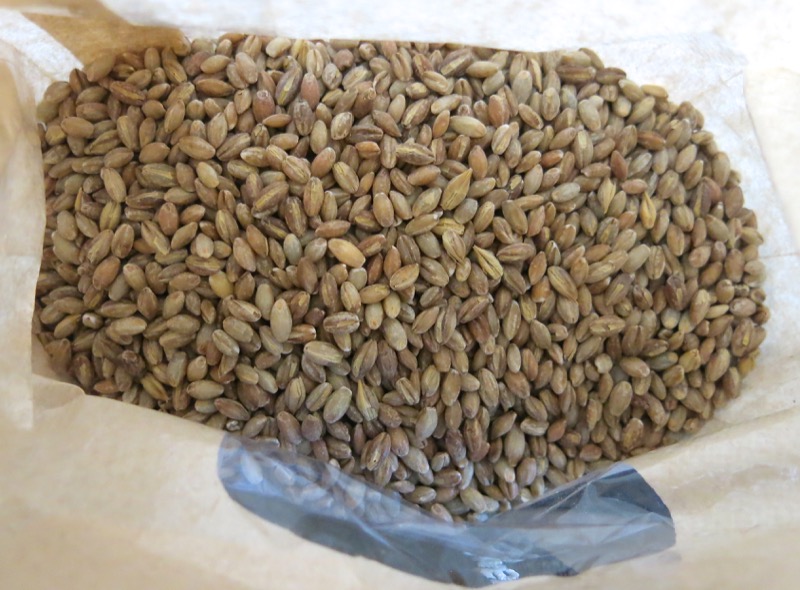
Diastatic malt is a grain product that has sprouted, been dried and ground into powder. Sprouting the grain (most often barley, as it is much more cost effective than wheat) activates enzymes inside of the grain. Active enzymes are called “Diastase”. Diastase enzymes breaks down starch into a simple sugar called maltose that yeast loves to gobble up; maltose is made in abundance by the enzymes. This release of sugar from flour due to the addition of diastatic malt powder, enhances the growth of yeast as it feeds upon the sugars. This process promotes a golden crunchy crust, stronger rise and firm spring in a loaf. Surprisingly, this ingredient will also punctuate and heighten the flavour of the grains in the baked bread. Generally, one teaspoon is used in the recipe, per loaf.
Diastatic means having the properties of diastase (an enzyme that breaks down starch into maltose), thus “Diastatic Malt Powder.”
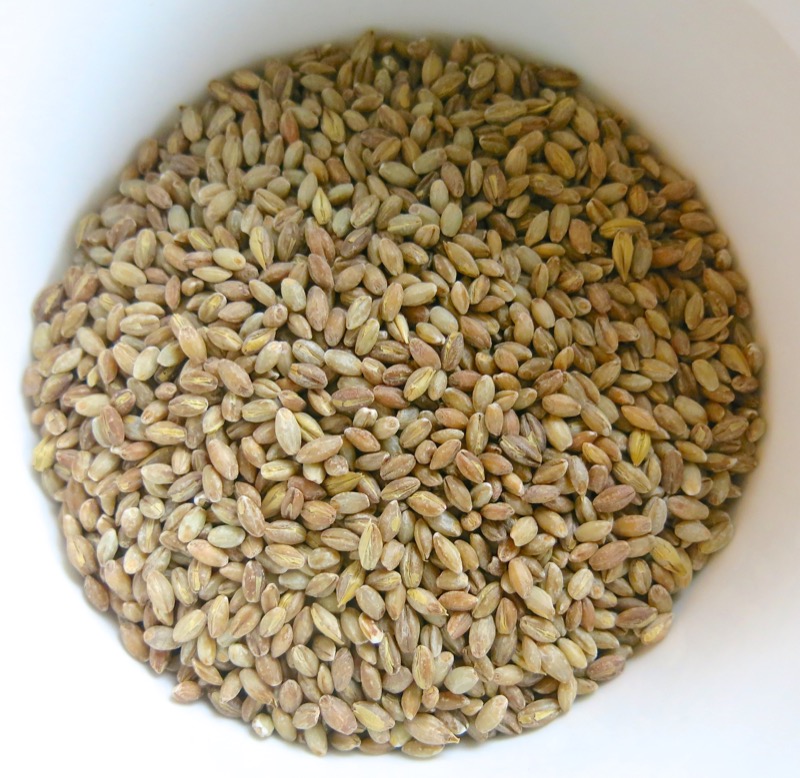
Though scientific in nature, and seemingly complicated, this can be made in three easy steps:
- Sprout grain
- Dry sprouted grain
- Grind dried grain into powder
To make this Diastatic Malt Powder, one needs organic raw hulled barley or wheat seed. We were going with barley. Where or where? My favourite Farmer John, of course! Oh, what a labour of love that was on both our parts. I phone and ordered the barley seed. He was so busy that he forgot to put it in the load for the Saturday market, so I just brought home a bag of his gorgeous organic barley that I use in soups and risottos. He was sure it would sprout.
 Step One: Sprout Grain
Step One: Sprout Grain
Day 1: Wash and soak the barley overnight; strain it and cover tightly for 12 hours.
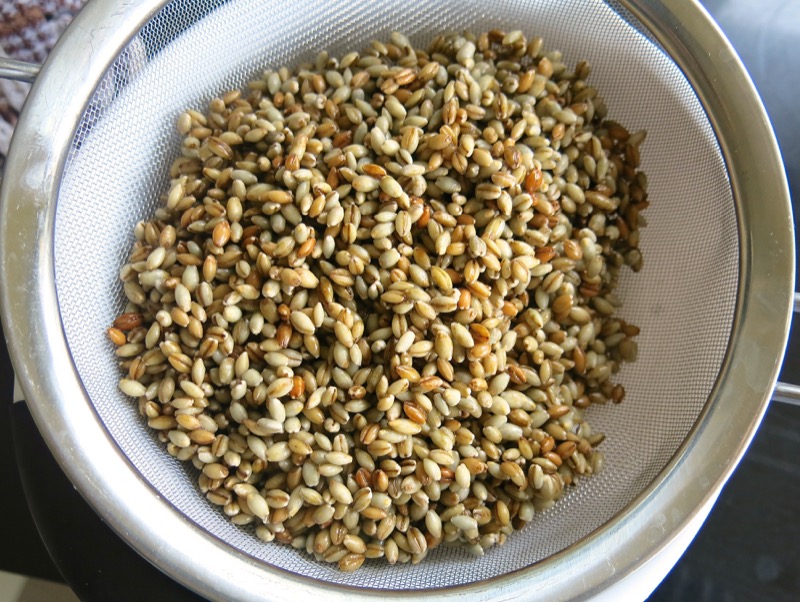
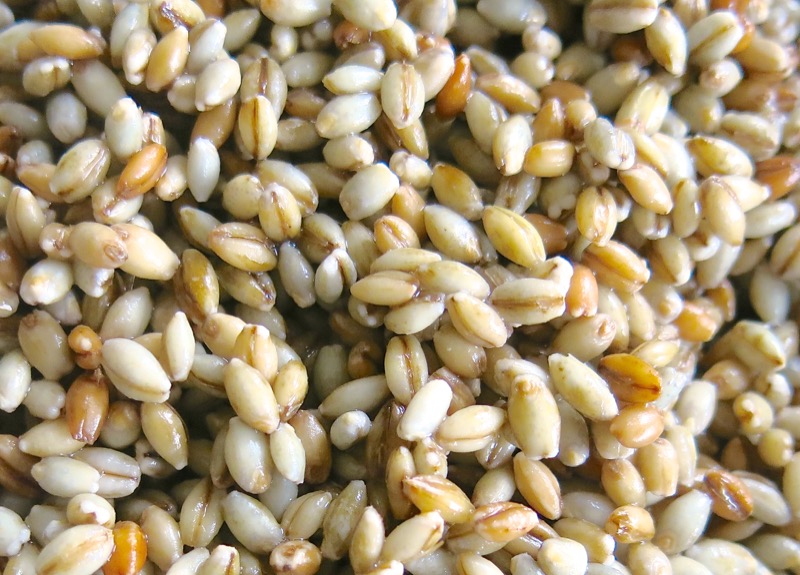
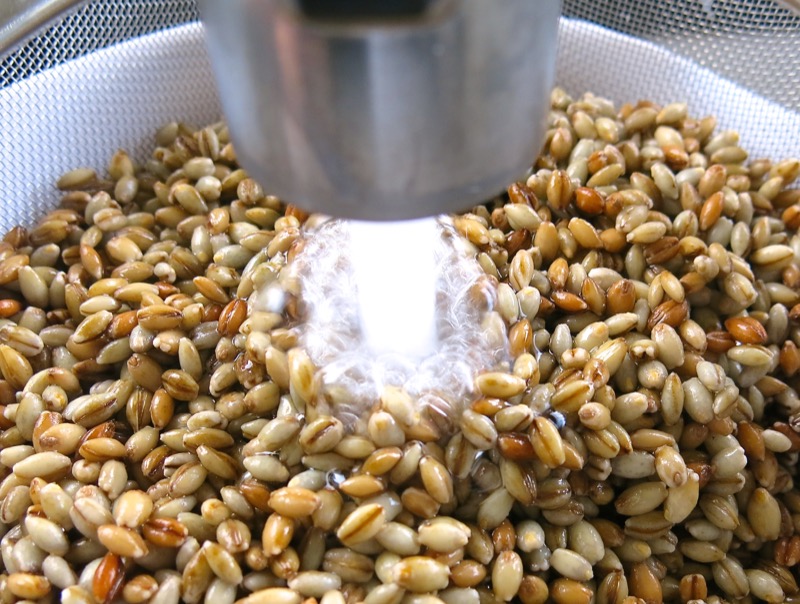
Wash every 12 hours, strain and cover tightly until grain sprouts.
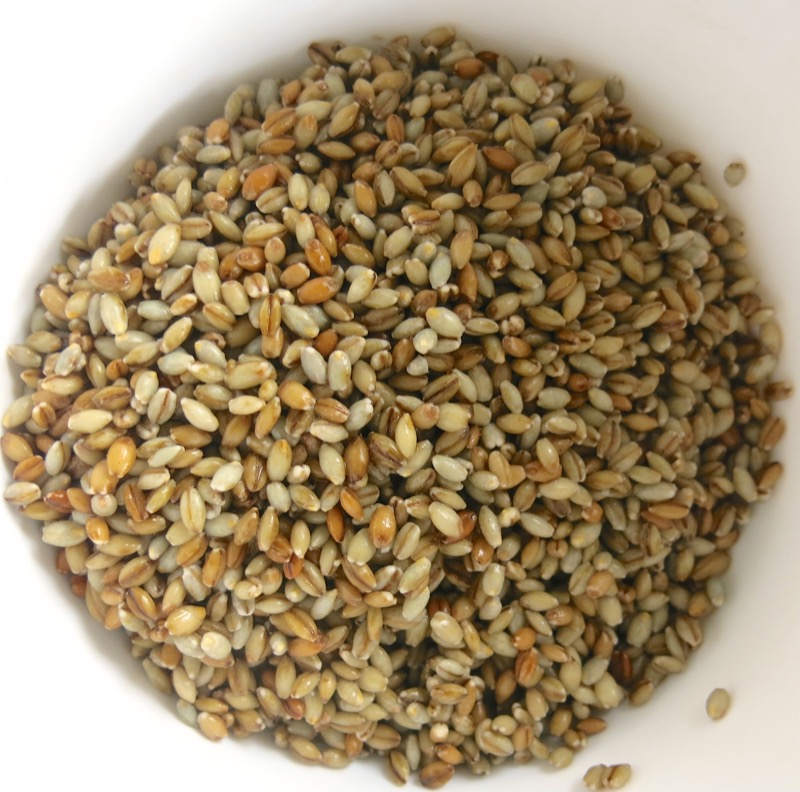
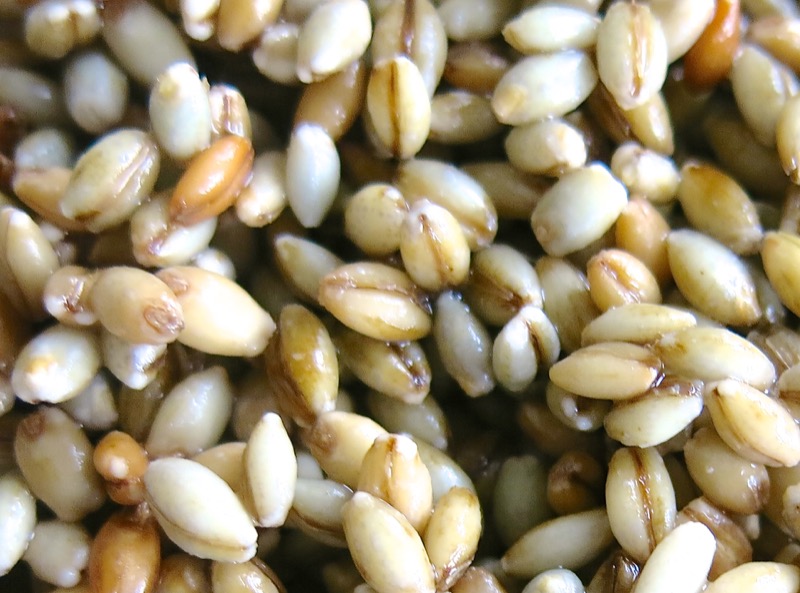
See the sprouts? I didn’t either. That’s why the organic hulled barley I bought from Farmer John MAY have worked. I thought the sprouts would look like Monkey tails, not little white knobs. Oh, my. So, after 5 days of working to get sprouts, I called him and he brought barley to the market that was not hulled or cleaned. Nope. That’s not going to work. We picked up another back of cleaned barley a couple of days later, different time, different place. Five days and a whole lotta money later, no sprouts.
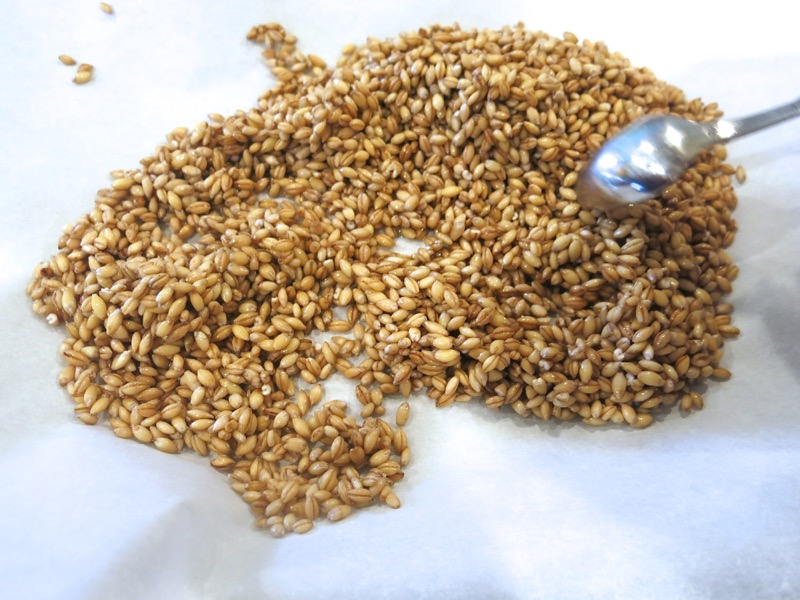
Now, at this point, John had gone considerably out of his way to provide me with barley that would sprout (and likely had); we had gone considerably out of our way to make it happen with his gorgeous seed. But, nope. So, I asked Matthias where he got his. Planet Organic. Three dollars and 50 cents later, I had a huge bag of organic (not locally grown) hulled barley. The day of the Thermomix Consultant Meeting and Christmas Party it was to be “sprouted” and I showed Matthais, full of disappointment, how – yet, again – my barley did not sprout! He looked at me like I was nuts!
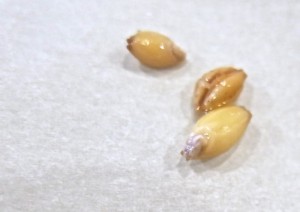
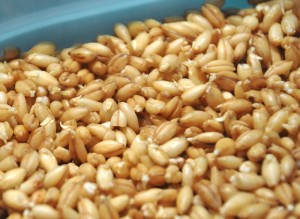
“But, Valerie! It has sprouted! Can you not see that. There! Look! And there, and there! It is perfect!” Of course I looked and saw nothing. “Where?” Judith, his wife, pointed out the three kernals above, left. “Look at the while bulge in the center of each berry.” She said, and pointed to more, “And look at the tiny white purple sprout at the end, here.”
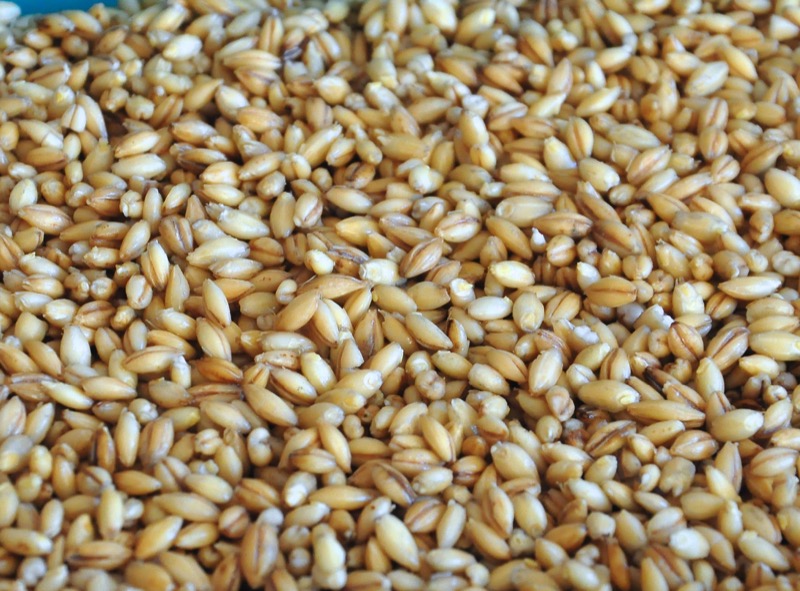
Really? This is what sprouting barley looks like? Yes, it is! Well, that was easy then! Well, it will be for you. You can thank me for sharing my truck load of ignorance with you so you can learn from it and enjoy success the first time you sprout gorgeous organic barley.
 Step Two: Dry Sprouted Grain
Step Two: Dry Sprouted Grain
It was a 4 hour meeting. I had the grains air drying for a good hour or two after Matthias and Judith told me that they were ready for the oven. Judith then placed them single layer on the lined cookie sheet for me.
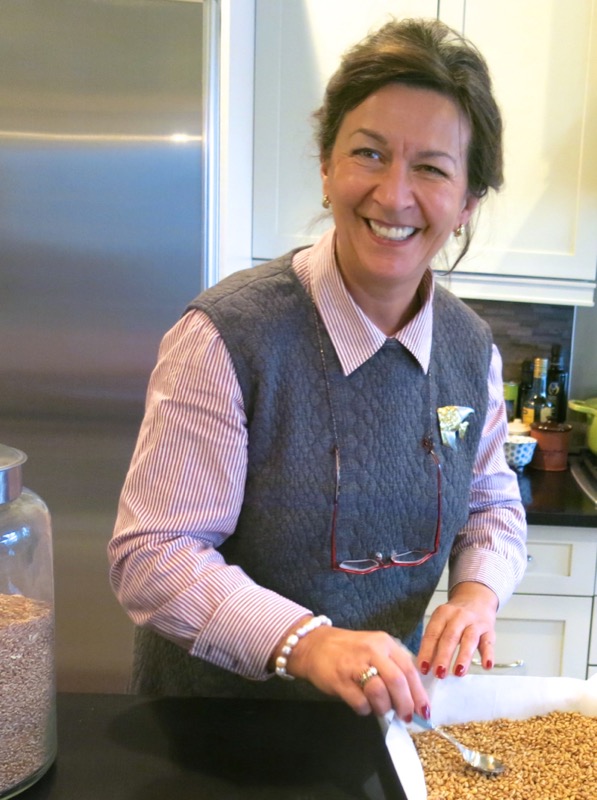
The enzymes may be damaged or die at 55 ºC or 130 ºF, so do not heat above 40 ºC or 104 ºF. They can be dried at room temperature, spread on a baking sheet lined on baking paper in a window sill, but it may take a couple of days. That way, you will be sure all enzyme properties are in tact. The grains are ready when they are dried completely and have turned rock solid again.
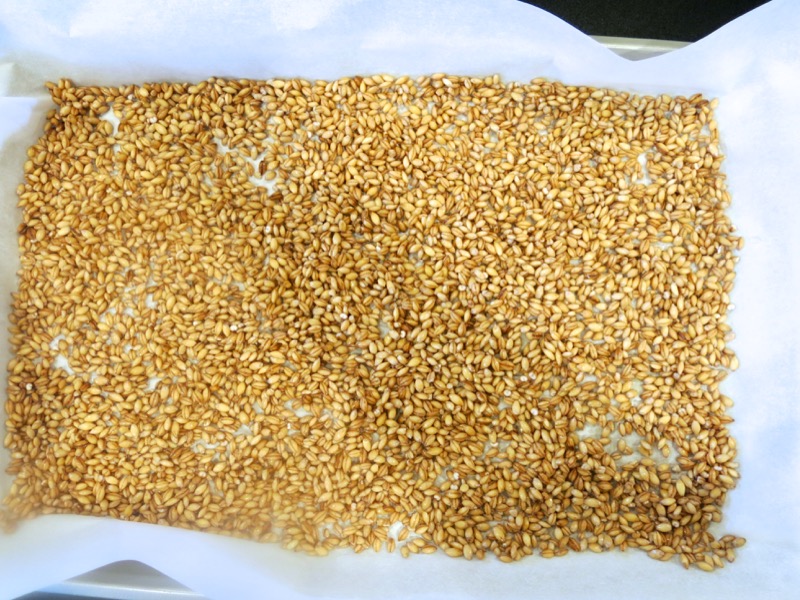
Not for too long. As soon as it started to smell very tasty, out it came. They were once again rock solid.
 Step Three: Grind Dried Sprouted Grain into Powder
Step Three: Grind Dried Sprouted Grain into Powder
Into the Thermomix for milling. (Above photo is Mattias Reissner’s photo, with permission.)
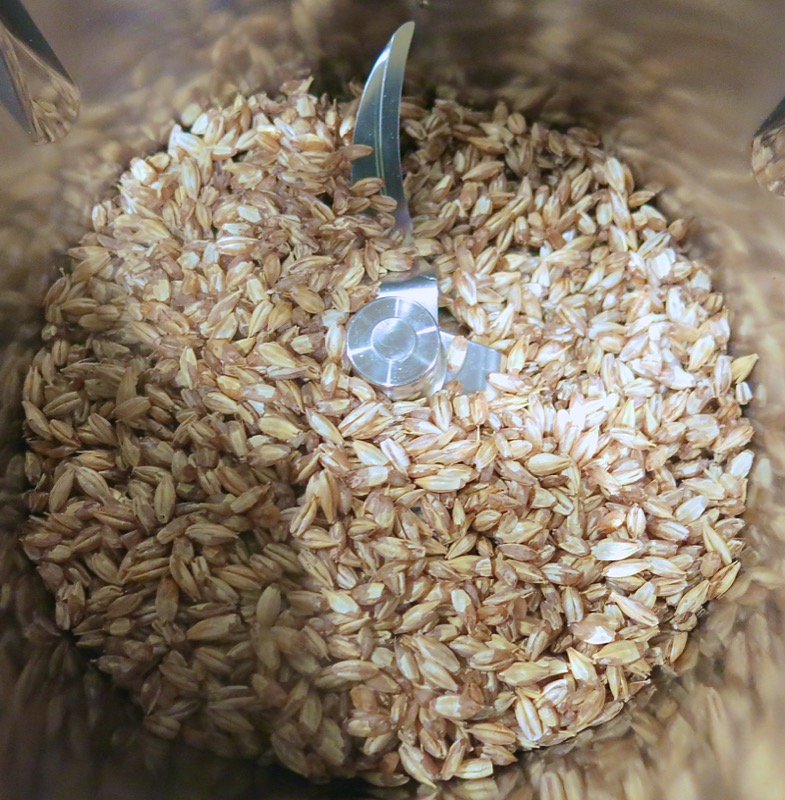
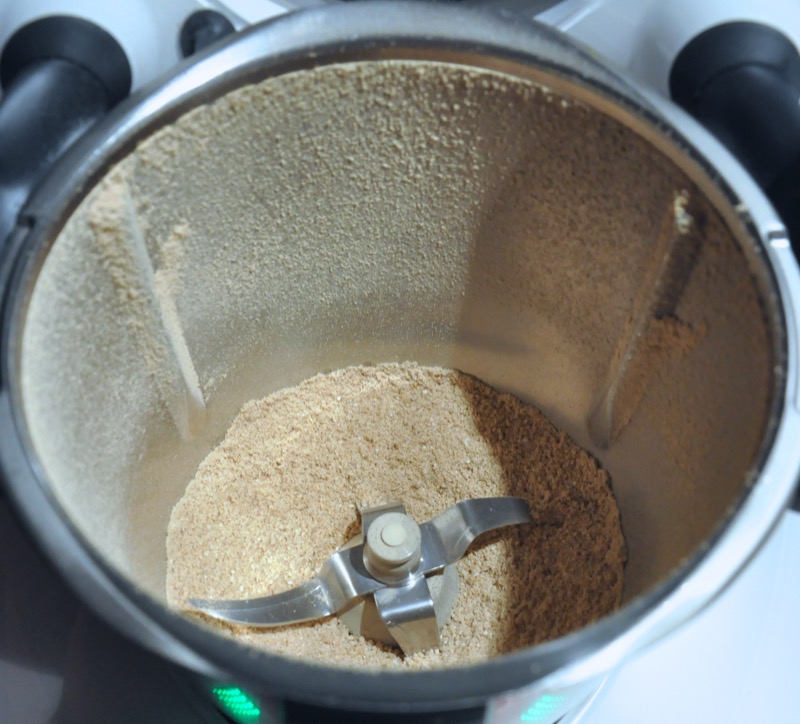
And, voilá! Gorgeous, homemade Diastatic Malt Powder that will last for months sealed well in the fridge with only a little needed per recipe. (Above photo is Mattias Reissner’s photo, with permission.)
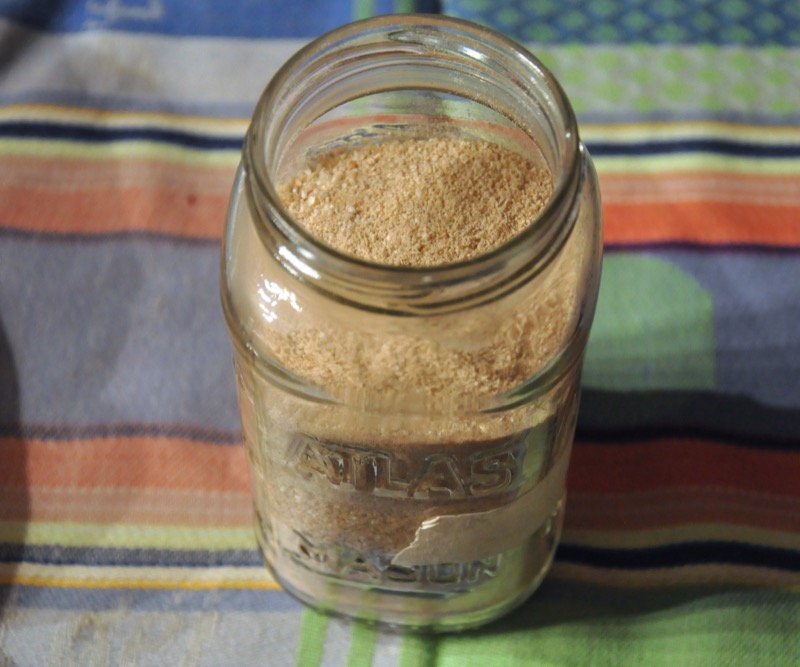
This is the amount that an entire batch will make. (Above photo is Mattias Reissner’s photo, with permission.)
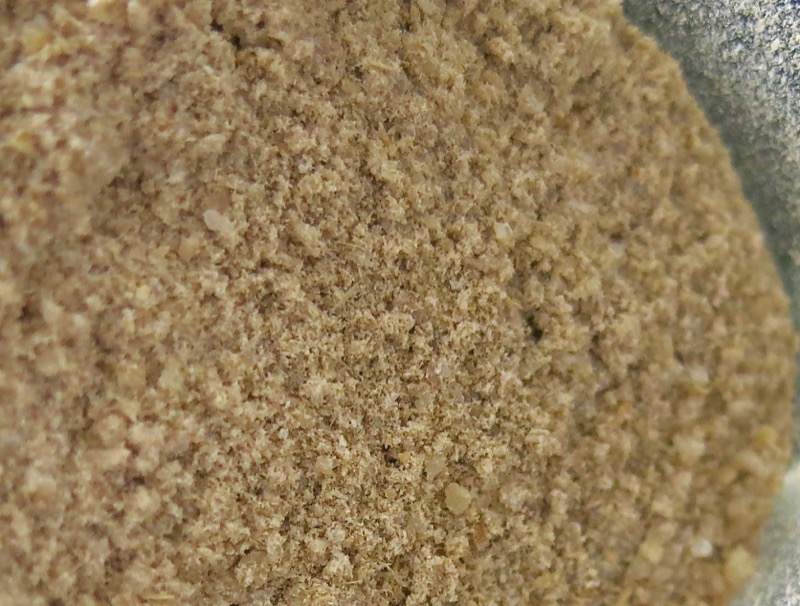
Below is one quarter of the batch and still enough for a few great loaves of bread!
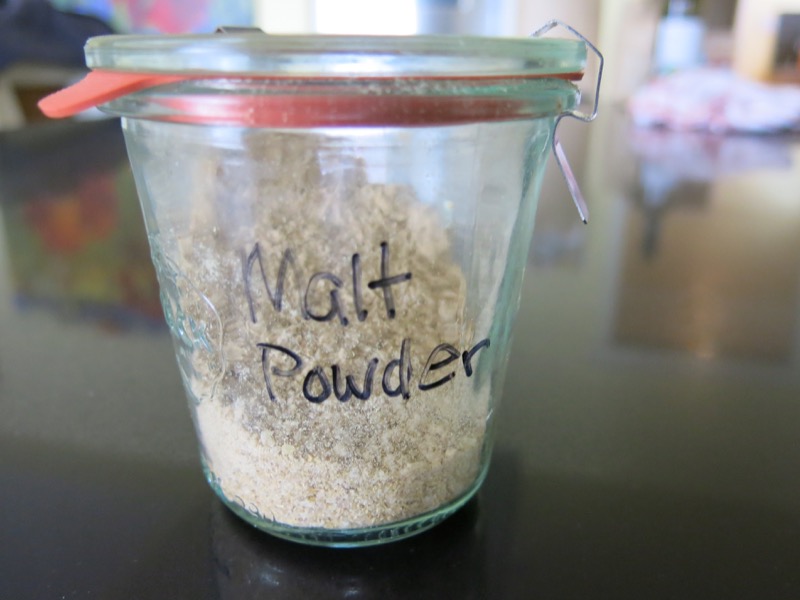
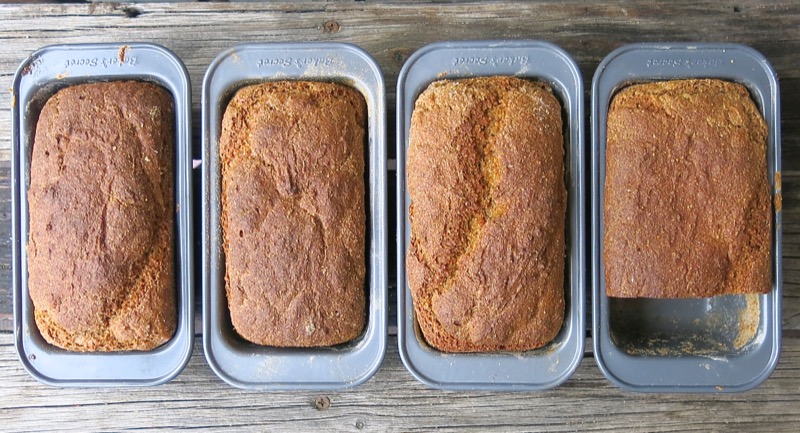
The crust, the flavour, the loft… I could go on, and certainly did in my post about German Brown Bread. I cannot wait to use this in my Baguette Recipe to see what happens there… or any of my other favourite bread doughs!
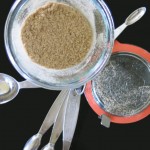
Sprouted Barley Malt Powder or Diastatic Malt Powder
Matthais Reissner is an engineer and a passionate baker. This recipe is one of the necessary components for his famous dark German Rye Bread.
Ingredients
- 200 g organic hulled barley seed
- water
Instructions
-
Place 200 grams organic barley in small, flat container; cover with water
-
Place a mesh screen or weight over barley to ensure grain remains underwater; soak for 12 hours, or overnight
-
Strain water from barley; allow 12 hours rest covered with plastic wrap, or lid, at room temperature on counter (you will repeat this process 2 more times)
-
Rinse grain with water; again allow 12 hours rest covered with plastic wrap, or lid, at room temperature on the counter
-
Again, rinse grain with water; allow 12 hours rest covered with plastic wrap, or lid, at room temperature on the counter
-
Barley will begin to sprout; distribute in single layer on parchment paper covered baking tray (barley cannot be covering one another)
-
Dry at room temperature, turning every 6 hours or so, until rock hard once again (see notes for additional drying options)
-
Place dried barley in TM5 bowl for 1 minute at speed 10; store in seal-able glass container in the refrigerator (will keep well for several months)
-
Congratulations! You have made your own organic diastatic malt powder ready for use!
Recipe Notes
Do not heat above 40 ºC or 104 ºF or the enzymes may be damaged or destroyed
If you choose to dry at room temperature, turn every 6 hours so the bottom of all grains are evenly dried; this can take up to 2 days
If you have a food dehydrator or oven which can be set to 40 ºC or 104 ºF, you can put the baking sheet in the preheated oven 3 to 4 hours
This will store for several weeks, well sealed, in the fridge
It’s easy, fast to process and inexpensive; the perfect condiment for bread baking
Matthias won’t do his bread without it anymore
Please do chime in if you have ever used this, made it, or heard of it. Let’s chat bread making!
 Step One: Sprout Grain
Step One: Sprout Grain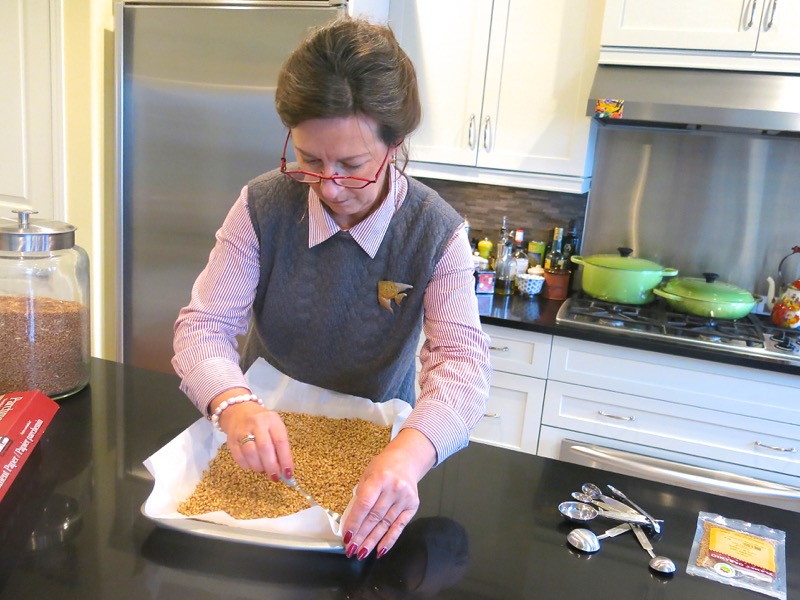 Step Two: Dry Sprouted Grain
Step Two: Dry Sprouted Grain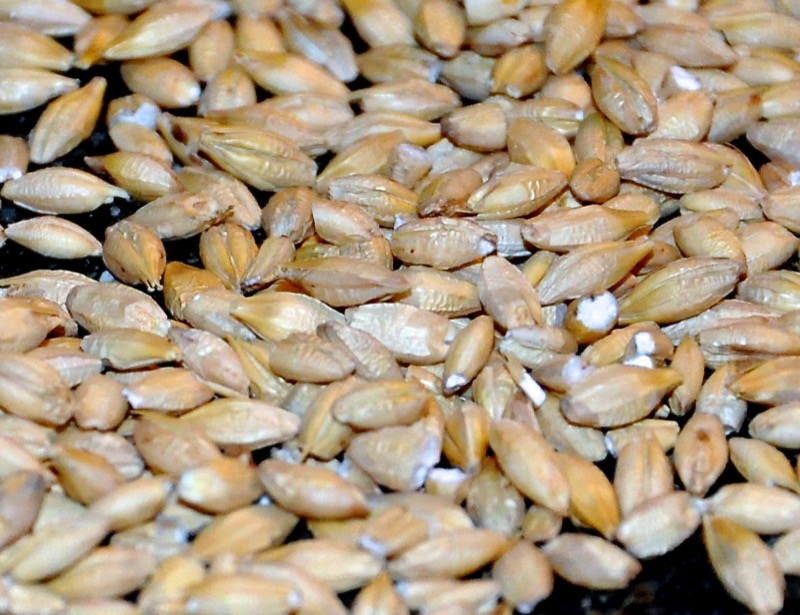 Step Three: Grind Dried Sprouted Grain into Powder
Step Three: Grind Dried Sprouted Grain into Powder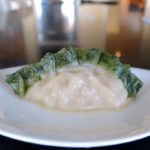

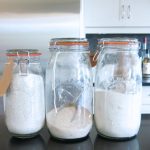
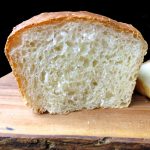
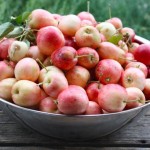




If you crush or grind up the wet sprouted barley, and press it into thin cakes before drying, it makes a sweet, light and energy-intense snack to take along hiking or snowshoeing, etc. I’ve wondered if the “lembas” of the ?elves? in Tolkein’s Lord of the Rings series might not have been based on such malt cakes.
The mash, cake or powder is used in making malt syrup … it’s added to a warm cooked grain porridge, which is held at the not-hot-enough-to-kill temperature to develop the sugar, and then brought to the boil before it begins to produce alcohol. I made it with rice, to make rice malt, long ago. I can’t say I considered it to be a roaring success, but we put it into pancakes which my little one pronounced delicious.
I’ve heard rumors that during prohibition, my grandfather used to make both “malt drink” and whiskey … (sssssshtttt!)
And my parents and grandparents also mentioned using malt for baking “treats” during the years sugar was rationed, and before that during the Depression, when it was just too expensive. I remember some baking (though not whether Grandma’s or Mom’s) that substituted light molasses and corn syrup for malt syrup …)
Throughout the Depression and then the war-time rationing, they also made some kind of grain coffee substitute that involved some malt as well. However, unlike with the case of the baked goods, that beverage was so not well-loved, and as far as I know there was never any urge by anyone to go back to it!
That having been said, there used to be a popular coffee substitute made of roasted barley, barley malt and roasted chicory or dandelion roots.
All the best of the season to everyone. Merry Christmas!
Hi Valerie,
I’m trying to make the diastatic malt powder and I don’t seem to be able to sprout the organic barley. How many days did it take for yours to sprout. I have been rinsing it once a day for the last 7days. The grain is in a large tupperware bowl with a lid on it and set on the counter.There are no purple /white ends on the grains. They just look puffed up and soft.
Joan!
Wonderful to hear from you! You will love this bread! The little ends sprout – use a magnifying glass if your eyes are anything like mine, maybe? Did you buy them from planet organic? If so, they will definitely sprout. Remember soak and wash and rinse, then just rinse without soaking as per the directions. Let me know if this makes sense. It is worth it. Mine were sprouting, and I didn’t even realize it as the little white roots were so small. That’s why I tried to show in the magnified photo.
Hope this helps?
Valerie
Yeah! They have sprouted. Didn’t think a little grain could get me so excited. I can’t wait to dry the barley and make the bread. Thanks Valerie .
Joan
Thrilled to hear this, Joan! let me know how you enjoy the bread. I absolutely love it!
Hugs,
Valerie
Hi Valerie,
I just pulled the bread out of the oven and my kitchen is filled with the wonderful aroma of baked bread. I added dried cranberries and walnuts to the dough before baking it . It is deeeelicious! I will definitely be making this again. Check out my pic on instagram.
Thrilled Joan! And over 60% fiber in this recipe. Isn’t that phenomenal? Once you have the starter and the malt powder, it is an easy go from there. I have actually continued to make 4 small loaves in my mini pans. I freeze three, as I am the only one that eats it, and it is very moist and will grow mold much quicker than a loaf laden with preservatives. Mattias makes a double batch at once and does a massive free form loaf.
I am just thrilled you were motivated to try it and that you love it!
Hugs,
Valerie
I’ve been on the hunt for a replica of my favourite bread from Germany and yours looks exactly it.
I’m on the hunt for the right barley and will give this a go.
Wouldn’t the dried barley last longer whole? Which means you’d only mill what you need as you need it. I’m basing this on how coffee beans last must longer whole and only ground prior to use.
The barley is used for the desiccated malt powder – so you sprout it, dry it and then mill it. It will last a very long time in this format. OR you can just purchase the desiccated malt powder. This bread is DElICIOUS! Let me know how it goes!
🙂
Valerie
Ive dried the sprouted wheat in the oven. The lowest setting on my oven is 170 degrees and I’m wondering if that is too hot. I’ve used this in my breads for years and it is wonderful. I bake breads for a local Farmers Market , 3 days a week.
Good for you, Lois, I think that is an OK temperature to dry the sprouted wheat at. My oven is the same and it worked for me!
🙂
Valerie
Pearl barley does not sprout. Perhaps that is what you got. It is harder to find sprouting barley. Rural supply place might be the place to go?
Thanks, Kay
I actually went to my local grain supplier at the farmer’s market and he got me the correct grain.
It may be a different strain as I was told it DID sprout when my mentor saw it, but I had to use a magnifying glass (almost – haha) to see it as the root was very small.
🙂
Valerie
Thank you for sharing this! I’m very excited to try it out.
Hello! First time visitor and commenter here, but I can already see that I will be a regular visitor here. I’m definitely going to make some of this diastatic malt powder, and I am also wondering if it would have a use in smoothies?? I use wheat germ along with hemp hearts, chia seeds, etc. and am wondering if this would be a healthy, flavourful addition? Perhaps not. I’ll go forward with that wonderful-sounding bread, regardless!
Tamara,
Welcome! Wonderful to have you chime in. I think it is “the other” malt powder that would be flavourful in smoothies. The purpose of this one is to change the starch in glutens to sugar… so it is for breads.
Let me know how your bread turns out … I cannot sing its praises enough!
🙂
Valerie
Do you know how the recipe would change if you used wheat instead of barley? I have wheat seeds that I could sprout but not sure if that’ll work.
Erin, that is a completely different “thing”. Just google recipes for it and you will find other routes.
Let me know how it goes. I love the flavour of this one.
But understand you wanting to use your wheat, too!
🙂
Valerie
Pre malted barley and wheat can be purchased cheaply (usually less than $2/lb) at stores that sell supplies for homebrewing beer. Look for 2-row base malt (barley) or malted wheat and skip having to malt the grains yourself.
Thanks for the great tip, Phil!
🙂
Valerie
hello im so pleased to see this recipe because i saw a recipe calling for this and thought it would be impossible to make or source. I will be making this as part of my culinary school healthy options assessment a great recipe is to use it in mash potatoes instead of cream milk or butter it breaks down the starch and makes a sweetish creamy silky puree without the tonnes of butter and cream.. a great little tip thank you so much for this recipe
Thank you for the tip, Dylan. What would be the ratio of powder to potatoes for the mash?
🙂
Valerie
You can also find malted grains at you local homebrew store. Use a pilsner malt or something equally light in color. Even faster, although slightly more expensive in the same store is dried malt extract. Heaps faster and less expensive and for me, easier to find.
Thank you, Eric!
🙂
Valerie
Hi Valerie,
I have a question about the recipe.
I am currently at Day 1 of air drying the barley after sprouting. It has sprouted already and looks great.
My question is about a rich sour aroma it is omitting.. Is this normal. The smell is quite intense, but I’m assuming that’s because it is fermenting?
I hope you can help.
Kind regards,
Adam.
If mine had a strong smell, Adam, I would have written about it, so didn’t have the same experience and really don’t know.
Hopefully, someone else will chime in!
Sorry to hear it!
🙂
Valerie
Hi Valérie! I am so glade to find out about your diastatic powder. Mine is restign right now. It seems like my barley sprout very fast. After letting it rest over night, I allready saw some sprout! But now I am affraid that the sprout fall from the grain when I rinse them?… Could it? And if so, does it matter? The gold is to have the sprout or for the grain to attempt this point???? Excuse my english! Hope you understand me correctly! Have a nice day! Thank you! Annie
The sprouts should not fall from the grain when rinsed, Annie, but you must be fairly gentle with them. Simply place them all in a sieve to rinse. I really don’t believe that it should matter, but I am truly not an expert at this. I just followed Mathias’s instructions to a “T” and checked back with him as I had difficulty with getting my grain to sprout at all. When he saw mine, he said they were great, but I could barely see they had sprouted, so this is a question for someone else and I hope a reader here will help you. I believe, as it is dried after sprouting, common sense tells me it shouldn’t matter. Let’s hope common sense applies here!
🙂
Valerie
Since you’re pulverizing this to a powder and using such a small amount per loaf, would you be concerned about using whole malted barley rather than going through the malting/sprouting process yourself? I’m a brewer and I bake a little so this was exciting to see but the whole time I was wondering why not just use malted barley. You could buy it online or find a local homebrew shop. The only difference is that it still has the hull on it. You would also get a lot higher diastatic power than by doing it yourself which would mean you could use less per loaf. I’m curious about your thoughts on this.
HaHa! Good point, Steve! I thought of exactly the same thing once I’d finished the process. It was a great learning curve. I will likely buy in the future,but really didn’t know where at the time so making from scratch was part of the process shared with me – and I was ALL IN!
Glad I did it as this is the best German Brown Bread I have ever eaten and really, one of the top three breads I’ve tasted in my life.
Did you make the recipe for the bread?
🙂
Valerie
Grateful to find this information and so beautifully presented!
Can you tell me what the shelf life of the malt powder is?
Thank you for sharing this!
I would say at least 6 months – maybe more if frozen.
🙂
Valerie
Ahhh…just thought of another question…after the sprouting and drying process…is it necessary break off the roots before grinding?
I wouldn’t think so, but have noticed in other videos that that is part of the process.
You know, Donna, I am certainly no expert. I didn’t and don’t see that as important when they are being ground anyway.
🙂
Valerie
?Thank you Valerie…I’m good to go now…much appreciate your help!?
Hello again…almost ready to grind…very close to pizza day ?…can you tell me if you should use the berries that did not sprout?
I am sure I didn’t examine them that closely, Donna, as long as most have sprouted.
🙂
Valerie
Hi Valerie,
I am situated in the Philippines and Diastatic Malt power is hard to find here. Through research my husband came across you site.
I really wanted to try this (if I could find a Barley) however I have one question. Do you include the husk in sprouting and grinding? Or should your Barley be cleaned without husk, if so would it sprout?
Thank you.
I really can’t recall, Rosalie.
I believe it is all there, but look at the close-up photos.
That will help!
🙂
Valerie
Hello:
Does it have to be organic barley? I seem to be having trouble finding it. I would really like to add the powder to my breads. Many recipes seem to call for it.
Thanks,
Linda
No, Linda.
Hugs
Valerie
Hi Valerie, do you think this malt powder can be used to make malted milk drinks?
Thank you!
Hi Yun, Malt powder comes in two forms: diastatic and non-diastatic. Diastatic malt powder contains active enzymes that help convert starch into sugar. This action can accelerate the rising process and make bread rise more quickly. It can usually be found in powdered form.
Non-diastatic malt is only used for that distinctive malty flavor and deep caramel color. It does not contain any active enzymes and is available as a syrup
I have never made malted milk ice cream or candies, so really have no idea.
Hope this helps.
Valerie
Thank you for the step by step instructions with pics – was wondering if one can make the malt with Gluten free grains like sorghum, millet or buckwheat.
Found a recipe that calls for brewers yeast and malt so i was wondering if i could make my own malt.
Stay Safe thank you
I answered you privately, but I really do not know as I haven’t done it, June.
:)P
Valerie
I am a homebrewer and normally have surplus grains available, since I by in bulk, and was wondering can I just powder some of my Pilsner malt (which is kilned at a temperature of between 40 and 45 degrees C) as a substitute for the sprouting and drying barley grain step you describe?
Hi Dennis,
Maybe someone else can help you here? I’ve not done that.
🙂
Valerie